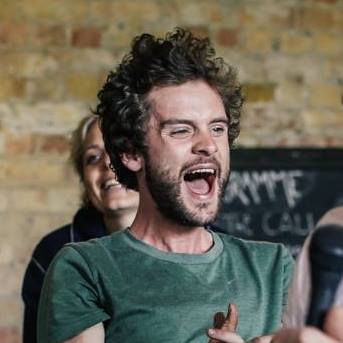Our latest news
Opening Up – Collective Joy in Prison and Beyond
‘Hozho is not something you can experience on your own,
the eagles tell us as they lock talons in the stratosphere
and fall to the earth as one.
Hozho is interbeauty.’
Lyla June Johnston – Hozho
As a trainee Good Vibrations facilitator, my first visit to a prison was not a typical one. As I approached the grey, hunched, fort-like building, went through security, and was led through a maze of corridors, locked doors and barbed wire fence I felt my body tense up with claustrophobia and anxiety. This combined uneasily with the guilty relief that I was a visitor – not a resident – of such a place. Yet not long after this, I was in a nondescript backroom surrounded by tuned, ornate bronze Gamelan instruments resonating together in harmony, improvising and composing a unique and beautiful piece of music (listen below) with a group of smiling strangers. My nervous system was confused, to say the least.
I don’t recall exactly when I heard the expression ‘collective joy’, but I remember that satisfying sense of something being named which needed naming. In a basic sense, it refers to that transcendent feeling of connection and creative communion we can experience only in relationship with others. We need collective joy, and, after a year of lockdown restrictions and enforced ‘social isolation’, we are missing it now, more than ever. As such, we are in a better position than usual to imagine, in some miniscule way, what life might be like for the 80,000 odd people in the UK – and some nine million worldwide – who were isolated in prisons before the pandemic, and have suffered even harsher conditions since, locked up for an average of 22 hours a day.

Is there even any such thing as joy which isn’t collective? According to Jeremy Gilbert, a cultural theory academic and DJ I interviewed last summer for Good Vibrations, joy is ‘always sort of collective. You can experience collective joy sitting quietly in a library, relating to people through reading their books…’ . Yet there is something particularly important about the ability to experience connection with other humans in the flesh; the multidimensional complexity of another being responding to your own complexity in the moment.
Collective joy is in no way a given in the presence of other humans of course – in a traffic jam, say, or at a gathering at which you feel unwelcome or disconnected from, or even fearful of, the people around you. Some degree of safety (both real and perceived) and trust in the people around you is a necessary condition for collective joy. It is inevitably hard to access in an oppressive institutional setting like a prison. This is one of the main problems with the existing criminal justice system, as Gilbert puts it: ‘there’s a tendency for prison to produce people who come out more alienated than they went in, and less able to effectively relate to other people around them’.
This analysis is borne out by another moving interview with Good Vibrations past participant and former prisoner, Russ Haynes: ‘You’re on guard 24/7… the way I survived was to close up… you’re careful who you speak to, you’re really careful about what you say, where you go, who you interact with… and all of that happening on a day to day basis can be really mentally exhausting’. Yet even small, genuine experiences of collective joy can cultivate the ability to trust in others and see collectivity as a source of potential joy, empowerment and liberation, as he described recalling his first experience of a gamelan workshop:
‘There was something about it that was so… and this sounds really cringey but it’s the only one I can use to describe it… so spiritual. I just felt there was a sense of freedom. It was the first time I felt truly free to express how I was feeling through music. It took me away from my environment. I remember how I felt, it was so calming, it was so spiritual, it was so relaxing. That stone of anger that I had inside me was starting to break away and I was not only connecting with the guys around me, but connecting with the battle I was having inside of myself at the time. And it opened me up to experience emotions that I was suppressing because of my anger, because I didn’t want to be perceived as weak as I felt. The whole thing gave me an experience I needed at the time, which was to be able to relax and feel something. For me, it was my first step to communicating with the outside world, which before I was refusing to let in.’
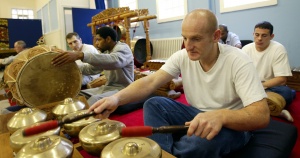
Gilbert’s understanding of the phenomenon of collective joy is influenced by the 17th Century German philosopher Baruch Spinoza. In this understanding, it refers to ‘that dimension of any experience which is a product of even a microscopic enhancement of a subject’s capacities’. Collective joy is a form of freedom in other words. Not the kind of freedom associated with the rugged individual (usually male) hero, enforcing his will upon the world, but the empowered freedom you feel when you transcend your limited capacity as an individual via acting together, consensually and creatively with others. Prison in this sense restricts not just your literal freedom to move, but your ability and your natural instinct to access liberatory forms of collectivity.
Collective joy, and the impacts of its absence, is not a topic relevant purely to the experience of prison, or even of lockdown. I think this concept means so much to me because, as someone who has experienced chronic depression since my early twenties, genuine collective joy feels like its opposite. Depression is the ultimate feeling of psychic isolation, alienation and disconnection; a prison of the soul. At its worst it is not a feeling of sadness, or even despair, but of nothingness, and it is very much a ‘disease of civilisation’ (i.e Western civilisation). Recovery and staying well for me has always been associated with an ability to reach out and connect with the people and the world around me.
The sad truth is, experiencing this kind of collectivity was, for many of us, an all too rare experience even before the pandemic. This is not to say we crave collectivity all of the time, of course. Many of us, myself included, need and appreciate ‘alone’ time, but we are social mammals nonetheless. Forced isolation, and its associated affective state, loneliness, is not just an unpleasant emotional reality impacting our mental health, but is increasingly recognised as a devastating threat to physical health with a mortality risk impact akin to smoking.
Before ‘socially isolating’ became a public health instruction, it was mostly known as a public health problem, with increasing attempts to address it, and identify its deep root causes. Some point to the loss of community and shared spaces of collectivity associated with the decline of religion. I formerly worked as a Community Organiser for secular congregational community Sunday Assembly, founding a new congregation in the East End of London. Sunday Assembly was founded in 2013 by two comedians, Sanderson Jones and Pippa Evans, who wanted to recreate the feelings of community and connection they remembered from attending church in their youth, without the framing of a faith they had since lost. They kept the basic ingredients of a church service; a reason to get up and be with others on a Sunday morning; a shared celebration of life in all its tragedy; an emphasis on community service and crucially communal singing – pop singalongs with a live band.
The first assemblies were a huge success and the idea quickly gained traction, leading to assemblies springing up around the world. Yet I remember the first time I attended an assembly, and the awkwardness and reluctance I felt – and felt others feel – when asked to stand and sing with a room of strangers. That feeling got easier to manage and bypass but never fully disappeared: though we crave it, collective joy doesn’t always come naturally anymore, because it’s culturally pretty alien to many of us. We can very quickly feel ‘self-conscious’ – worried about embarrassing our all-important individual selves. How many of us are able to dance and sing enthusiastically and freely without the aid of alcohol for instance? What does our culture do to our children – such natural dancers – to inhibit them from doing so when they grow up?
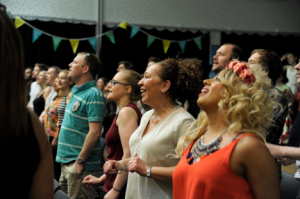
Sunday Assembly East End
This line of inquiry has inherently political implications. Gilbert places at least some of the blame on the dominant political and economic ideology forced on the world over the last 50 years: neoliberalism:
‘Under advanced capitalist culture, neoliberal culture, we are discouraged from experiencing collectivity as joyful, we’re encouraged to think of any meaningful or satisfying experience as being by its nature private… we are encouraged to feel that the only truly satisfying and meaningful agency in the world is to buy something and to consume it… we’re encouraged to think of every aspect of lives in terms of something that we’re acquiring, something we’re buying, something we’re making an investment in from everything from relationships to education.’
This loss has deeper and older roots, however, and it is perhaps no accident that Good Vibrations employs a non-Western (Indonesian) musical form to facilitate experiences of collective joy. In ‘Dancing in the Streets – A History of Collective Joy’ Barbara Ehrenreich details the fascination and horror of early European colonialists when they witnessed the ‘almost ubiquitous practice of ecstatic ritual’, in which large groups of people in the cultures they encountered would ‘dance, sing or chant to a state of exhaustion and, beyond that, sometimes trance’. Such examples of collective joy and ritual ‘ecstasy’ are well known to anthropologists as universal human impulses, which have had to be heavily repressed to facilitate the strange, lonely and disconnected individual selfhood prized and developed in the West, then exported forcibly upon the rest of world over the last five hundred years or so. Even now the forms of music and dance we associate with contemporary Western cultures of collective joy, from jazz to techno, largely have their roots in the African diaspora.
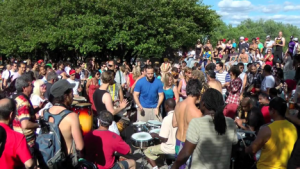
Weekly ‘Tam Tam’ jam session in Montreal, Quebec
Experiences of collective joy, particularly through music, can facilitate deep healing, in the most inhospitable of conditions, supporting people who are locked up, whether in literal and psychological cell, to experience, even for a moment, the possibility of a world beyond. Yet this has lessons for our wider culture too, about what we’ve lost and what we need to heal collectively. Going further, it may even have implications for our relationship to not just ourselves and each other but the natural world. Can opening up to the world beyond our individual selfhood begin to undo the dangerous disconnection from the ecological foundations of life, which has in no small part facilitated the devastation we continue to wreck upon it?
Collective Joy in this sense seems to me to relate to the untranslatable word ‘Hozho’, said to be the most important word in Diné Bizaad, a Native American language, and described by Navajo poet Lyla June Johnston (quoted at the beginning) as a sense of ‘interbeauty’, in which we feel intimately connected to all of life. As ecological activist and philosopher, Joanna Macy argues, to truly transform our relationship to the natural world, instead of ‘caring’ for nature as an abstract other, we must ‘extend our notions of self-interest; ‘it would not occur to me to plead with you, “Don’t saw off your leg. That would be an act of violence.” It wouldn’t occur to me because your leg is part of your body. Well, so are the trees in the Amazon rain basin. They are our external lungs. We are beginning to realize that the world is our body.’
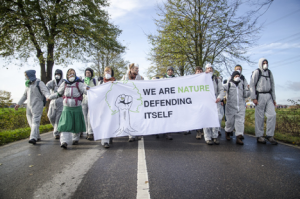
Ende Gelände anti-coal protest, 2016
This may sound like a standard hippie appeal to oneness. But the more we learn about ecology, biology and physics, the more it turns out the hippies were right, right? Everything is connected, and, like love, this reality is only a superficial cliche to the extent it is abstract and disembodied. When you truly experience it, you know it. You feel great, you smile at the people and the world around you, and feel part of it again… yet you also open up yourself to deep grief at the violence we regularly do to each other and the biosphere. To ourselves. In this sense perhaps collective joy can only truly be accessed if we are prepared to open ourselves up to collective grief. Perhaps this is the deepest reason so many of us are resistant to it.
Perhaps it is time to open the gates and let it all in.
You can support the excellent work of Good Vibrations by donating to my fundraising page. I’ve taken on the huge challenge of running the London Marathon for the first time on Sunday 3 October in aid of the charity. I’m aiming to raise at least £1,500, so any help towards that target would be greatly appreciated. Thank you!!
